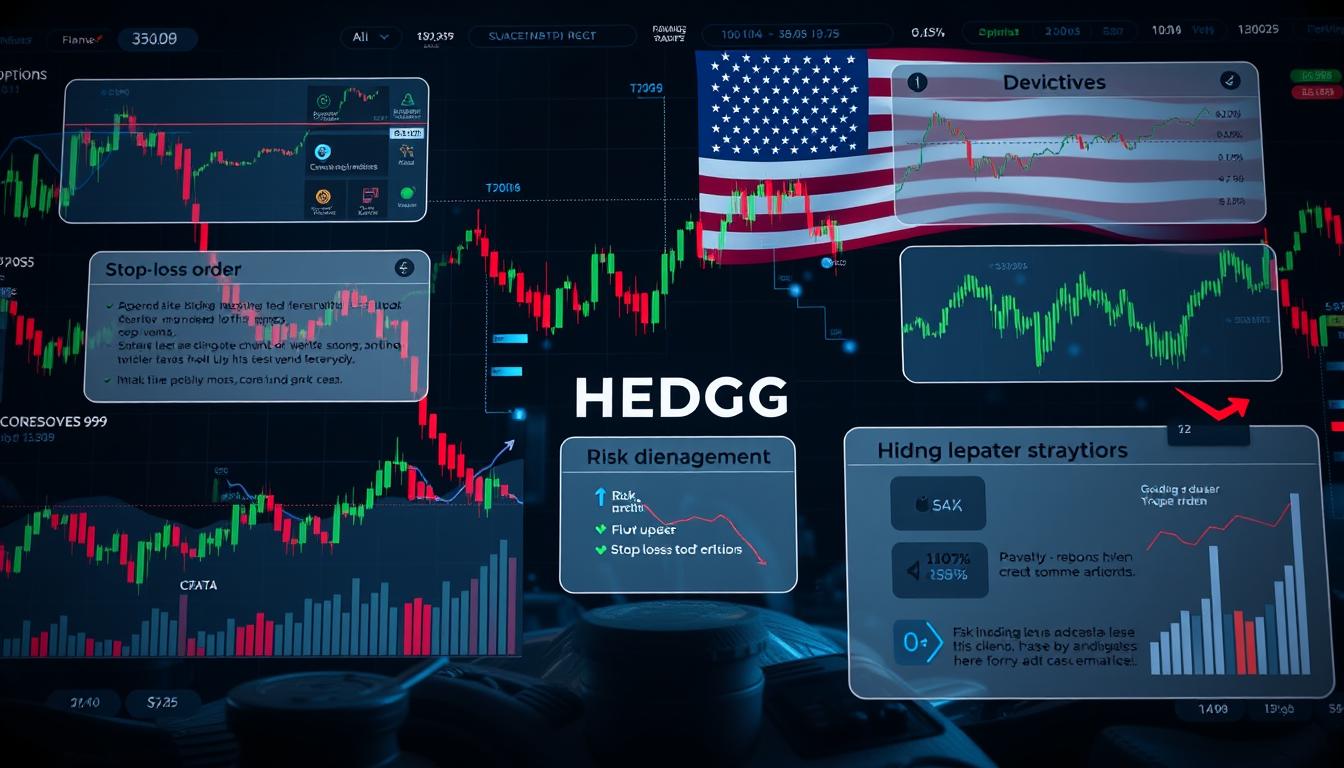Now Reading: American Investors: Hedge Against Crypto Volatility with These Tips
- 01
American Investors: Hedge Against Crypto Volatility with These Tips
American Investors: Hedge Against Crypto Volatility with These Tips

Cryptocurrency markets are known for their wild swings, leaving investors exposed to sudden losses. For American investors, navigating this instability requires smart strategies. This guide explores how to hedge against crypto volatility for American investors and outlines proven cryptocurrency risk management strategies to safeguard portfolios.
Volatility isn’t going away, but you can reduce its impact. Learn actionable steps like diversification, using stablecoins, and tax-aware hedging. Tailored for U.S. investors, these methods address regulatory rules and market trends unique to the American financial landscape.
Key Takeaways
- Effective hedging requires combining tools like options trading and asset allocation.
- Regulatory factors in the U.S. shape which hedging methods are safest and most compliant.
- Tools such as futures contracts and tax-loss harvesting protect capital without locking away investments.
- Monitoring on-chain data and market correlations strengthens decision-making.
- Emotional discipline and clear risk tolerance limits prevent impulsive choices during downturns.
Understanding Cryptocurrency Volatility in the US Market
Cryptocurrency markets in the US see big price changes due to many reasons. For those trying to keep their investment safe, knowing these reasons is key. These changes often come from new rules, tech breakthroughs, and world economic changes.
- Regulatory announcements: SEC decisions or proposals trigger sudden price moves.
- Liquidity gaps: Low trading volumes amplify price swings during market stress.
- Innovation cycles: New blockchain upgrades or product launches create speculative frenzies.
Historical Volatility Patterns of Major Cryptocurrencies
Bitcoin’s 2017 peak followed by a 2018 crash showed how sentiment drives extremes. Ethereum’s 2021 all-time high and subsequent correction mirrored similar patterns. These swings highlight the need for managing crypto investment risks effectively. Analysts note recurring 18–24 month cycles of hype and correction.
US Market Dynamics and Their Impact
US investors face unique pressures. Regulatory uncertainty from agencies like the CFTC creates volatility spikes. Overlapping Asian trading hours extend price turbulence into US daylight. Institutional inflows and outflows also magnify price movements, as seen during 2022’s Terra Luna collapse.
These factors make traditional hedging methods inadequate. Investors must adopt tailored strategies to preserve capital during inevitable swings.
Why American Investors Need Hedging Strategies
Crypto markets are very volatile, posing big threats to American investors. Sudden price changes can wipe out years of gains. In 2022, Bitcoin’s 60% drop erased $1 trillion from the market, showing how risky it is.
Protecting assets from crypto price swings is not just a choice—it’s a must for long-term success. This is especially true for those who have invested a lot in crypto.
US investors also face risks from unclear rules. SEC crackdowns or new tax rules can cause sudden sell-offs. For instance, in 2023, proposed crypto tax rules led to a 15% drop in Bitcoin prices.
These changes demand that investors take steps to protect themselves. They need to use hedging strategies to lessen their exposure.
Emotional decisions can make losses worse. Fear can lead to selling at the wrong time, locking in losses. Hedging helps investors avoid this trap. It keeps them focused on their long-term goals.
Retirement accounts tied to crypto are especially at risk. Sudden drops can ruin plans that took decades to build.
- Regulatory shifts: SEC actions directly impact US market stability
- Tax policy changes: New reporting rules increase volatility triggers
- Psychological resilience: Hedging curbs impulsive reactions to price drops
Protecting assets from crypto price swings requires more than just hope. With over 40% of American crypto investors holding more than $100k, it’s crucial to safeguard investments. This is the only way to keep wealth safe from constant price changes.
How to Hedge Against Crypto Volatility for American Investors
Starting with solid strategies is key for managing crypto risks in the US. Investors need to balance risk and follow rules. Key principles like spreading out investments, checking how assets move together, and managing how much to invest are crucial.

Basic Principles of Hedging in Cryptocurrency Markets
To hedge well, you must know how crypto assets relate to traditional markets. For example, Bitcoin’s price often follows big economic trends, as shown in OSL’s guide to crypto options. It’s smart to pick assets that move opposite to Bitcoin, like gold or stablecoins, to balance out losses. Always watch how your hedging tools perform.
Setting Up Your Risk Management Framework
- Track exposure across exchanges using IRS-compliant portfolio trackers
- Allocate no more than 5-10% of crypto holdings to volatile altcoins
- Use stop-loss orders and trailing stops to automate risk limits
Do regular stress tests to see how your portfolio would do in tough times. Use tools like Deribit and CME for futures contracts to hedge Bitcoin without selling your assets.
Determining Your Risk Tolerance
Investors in the US should think about their income and how long they can invest. Aggressive traders might handle bigger losses, but retirees should be more cautious. Data shows Bitcoin’s volatility is high, making it important to hedge. Begin by figuring out the biggest loss you can handle and set stop-loss levels accordingly.
Diversification as Your First Line of Defense
Smart diversification is key for cryptocurrency risk management strategies in the U.S. It spreads assets across different markets to lower the risk of sudden price drops. Start by knowing your risk level and then use proven models that match market cycles.
Asset Allocation Strategies for Crypto Investors
Here are some basic strategies:
- Conservative: 10-20% crypto with stablecoins and cash
- Moderate: 30-50% split among top 10 coins and DeFi
- Aggressive: 60-80% in unique assets like privacy coins
Correlation Analysis for Crypto Assets
Not all crypto pairs are created equal. In 2022’s bear market, Ethereum (ETH) had 78% correlation with Bitcoin (BTC). But privacy coins like Monero (XMR) only had 32% correlation. Use CoinMetrics to see how different assets move together:
- Smart contract platforms (Solana, Cardano)
- Privacy-focused assets (Zcash, Monero)
- Central bank digital currency (CBDC) trackers
Hybrid Portfolios for Balanced Risk
Mix crypto with traditional assets using:
- 60/40 stocks/crypto splits via platforms like Fidelity Crypto
- Treasury bonds as liquidity buffers
- Gold ETFs for inflation hedging
Rebalance every quarter to keep your portfolio balanced. This strategy helps manage risks while still benefiting from blockchain’s growth. Avoid putting all your eggs in one basket to protect your portfolio from market shocks.
Leveraging Stablecoins to Weather Market Storms
Stablecoins provide crypto market stability techniques for those wanting to protect their investments. These digital assets are tied to stable values like the US dollar. They serve as digital anchors in turbulent markets. For safeguarding investments in volatile markets, US investors have three main options:
- Fiat-collateralized: USDC and Gemini Dollar are backed by USD reserves in regulated banks, ensuring a 1:1 ratio.
- Crypto-collateralized: DAI uses crypto assets as collateral, balancing risk with decentralized features.
- Algorithmic: Projects like FRAX blend algorithms and collateral for stability, though riskier during extreme market shifts.
Automated triggers can prompt shifts to stablecoins when technical indicators like RSI extremes or 50% drops from 50-day moving averages appear. Platforms like Coinbase and Kraken make conversions easy. But, always check IRS guidance: converting crypto to stablecoins isn’t taxable, but records must track all transactions.
Investors shouldn’t let stablecoins sit idle. Platforms like Celsius or Nexo offer APYs up to 6% on USD-pegged holdings. DeFi protocols like Aave provide yield without sacrificing liquidity. Recent SEC proposals targeting stablecoin reserves highlight the need to verify custodian transparency before choosing a provider.
Combining stablecoin allocations with dollar-cost averaging strategies builds a dual shield against volatility. By integrating these tools, US investors can preserve capital without abandoning crypto’s long-term potential.
Options Trading Strategies for Cryptocurrency Protection
Options trading gives American investors tools to protecting assets from crypto price swings. This section explains how put options and collars work. It also talks about platforms where US traders can use these strategies legally.

Using Put Options to Set Price Floors
Put options act as insurance. They let holders sell crypto at a fixed price (strike price) before it expires. For example, buying a $30,000 Bitcoin put expiring in 30 days protects against drops below that level.
Choose strike prices 10-20% below current value. Align expiration dates with expected volatility periods.
Collar Strategies for American Crypto Investors
A collar combines a long put and short call to offset costs. Suppose an investor holds $50,000 in Ethereum. Buying a $40,000 put while selling a $60,000 call locks in a $20,000 price range.
This strategy reduces hedging costs but limits upside potential. Example scenarios: if ETH hits $35,000, the put gains offset losses; at $65,000, profits cap at $60,000.
US Platforms Offering Crypto Options Trading
- CME Group: Regulated Bitcoin options with $1,500/contract fees, best for institutional-scale hedging.
- FTX.US: Offers Ethereum and Bitcoin options with $0.05/contract fees and 24/7 trading access for retail users.
- Deribit: Popular with US traders using privacy-focused browsers, though access requires compliance checks.
- Paradigm: Focuses on transparent Bitcoin options with no negative balance risk for long positions.
Always verify platform licenses through the Commodity Futures Trading Commission (CFTC) before opening accounts. Start with small test trades using demo accounts. This helps master expiration cycles and Greeks metrics like delta and gamma.
Futures Contracts and Perpetual Swaps Explained
Futures and perpetual swaps help stabilize the crypto market. Futures are agreements to buy or sell assets at set prices, with a time limit. Perpetual swaps, on the other hand, mirror spot prices without an expiration date. Both options help US investors keep their portfolio safe from market ups and downs.
How to Establish Short Positions as Hedges
Shorting via futures can help traders make money when prices drop. This can balance out losses in other assets. Here’s how to do it:
- Calculate how much to hedge (e.g., 50% of Bitcoin holdings)
- Choose platforms like CME Group or FTX for regulated access
- Open short positions that match your spot exposure
Managing Funding Rates on Perpetual Contracts
Perpetual swaps use funding rates to keep prices in line with spot prices. Here’s how to manage them:
- Check rates daily with tools like Bybit or OKX analytics
- Adjust your hedge ratios when rates change a lot
- Roll your positions to new futures contracts before they expire
Regulated platforms set margin rules to prevent too much risk. Keep an eye on liquidation levels to avoid forced sales. These strategies, combined with careful risk management, are key to keeping US portfolios stable in the crypto market.
Dollar-Cost Averaging: A Simple Yet Effective Approach
Dollar-cost averaging (DCA) is a simple cryptocurrency risk management strategy for US investors. It involves investing fixed amounts at regular times. This method helps smooth out price changes.
By buying assets like Bitcoin or Ethereum at set times, investors avoid market timing. They also reduce the impact of sudden price changes.
Think of investing $200 every month for a year. When prices drop, you buy more. When prices rise, you buy less. This averages out your costs over time.
For example, investing $10,000 at a Bitcoin peak might lose value if prices drop. DCA spreads out your investments, reducing this risk. It helps avoid emotional buying and selling.
- Pick a schedule: Weekly, biweekly, or monthly contributions.
- Choose an amount based on your budget—no minimum required.
- Automate purchases via platforms like Coinbase or BlockFi to enforce discipline.
- Track performance over 6–12 months to observe cost averaging in action.
Use DCA with other cryptocurrency risk management strategies like stablecoins or options contracts. For taxes, keep records of each transaction. Platforms like CoinTracking can help with this.
DCA helps by removing guesswork and panic selling. It makes investing consistent. US investors become more resilient against crypto’s ups and downs while following risk mitigation for cryptocurrency investments best practices.
Tax Implications of Hedging for US Crypto Investors
Understanding tax rules is crucial for managing crypto risks. American investors need to know how the IRS views futures, options, and stablecoins. This knowledge helps avoid unexpected taxes. Using tax-loss harvesting and keeping good records can save money and follow the law.
IRS Classification of Hedging Instruments
The IRS sees crypto hedging tools as taxable. Futures/Options: gains and losses are taxed under Section 1256. Stablecoins: turning them into USD is taxed as a sale. Keeping detailed records might help qualify losses for tax deductions.
Tax-Loss Harvesting Strategies
- Avoid wash sales by waiting 31 days after selling to repurchase identical crypto
- Use a calendar-based approach: execute losses quarterly instead of year-end
- Monitor pending legislation like the Responsible Financial Innovation Act, which could alter crypto tax-loss rules
Record-Keeping Requirements
Keep track of all transactions with tools like CoinTracking or Koinly. Record: dates, wallet IDs, trade IDs, and fees. The IRS wants these records for three years past tax filing deadlines—or six years for crypto. Without them, you might face audits, hurting your risk management.
On-Chain Metrics to Monitor for Volatility Prediction
Watching on-chain metrics helps predict market volatility early. Analysts look at blockchain data to forecast price changes. Tools like Glassnode and Santiment give real-time insights for U.S. investors.
- Exchange inflow/outflow ratios showing user sentiment shifts
- Large transfers from whale wallets signaling potential sell-offs
- Stablecoin supply spikes indicating market uncertainty
- Mining hashrate drops warning of bearish cycles
- Transaction volume declines pointing to reduced market activity
In 2021, Ethereum’s transaction volume fell 40% before a big price drop. This pattern is clear through on-chain analysis. Platforms like Chainalysis let users set alerts for key metrics, helping to adjust positions in time.
However, metrics are less useful on privacy-focused blockchains like Monero. This is because Monero hides transaction data. Still, watching these metrics helps U.S. traders protect their investments from sudden price changes.
Institutional Hedging Tools Becoming Available to Retail Investors
For American investors looking to how to hedge against crypto volatility for American investors, new options are coming. Tools like ETFs and regulated funds are now available. They offer a way to manage risk with simpler rules and tax benefits.
Bitcoin ETFs and Their Role in Volatility Management
- ProShares Bitcoin Strategy ETF (BITO) tracks price movements using futures contracts.
- Valkyrie’s XBTF offers daily liquid access while avoiding direct crypto custody risks.
- Inverse ETFs like the ProShares Short Bitcoin Strategy ETF (BITI) let investors offset losses during downturns.
Regulated Crypto Investment Products in the US Market
- Grayscale Bitcoin Trust (GBTC) transitions to spot ETFs under SEC approvals.
- Closed-end funds like ARK Invest’s Block. Chain ETF combine crypto exposure with traditional fund structures.
- Structured notes and mining equities (e.g., Riot Blockchain) provide indirect exposure with defined risk parameters.
These tools make it easier to safeguard investments in volatile markets by using SEC oversight and tax benefits. Look at the costs and how easy they are to sell before adding them to your portfolio. Remember, there’s a trade-off between tracking error risks and owning crypto directly.
Automated Hedging Solutions and Trading Bots
Automated hedging solutions and trading bots are essential for cryptocurrency risk management strategies. They take action automatically to protect your investments when the market changes. Sites like eToro and Coinfloor offer easy-to-use options. Meanwhile, decentralized protocols like dYdX and 0x Protocol give you more control.

- Threshold-based systems adjust your investments when prices reach certain levels.
- Algorithmic platforms use smart strategies to manage your portfolio.
- Decentralized bots run on blockchains like Ethereum, giving you more freedom.
When choosing tools, look for strong security, check their past performance, and make sure they follow US laws. Tools like dynamic delta hedging or models based on how assets move can help keep your portfolio stable. For example, bots can use grid trading to catch small price changes or reduce risk during big drops.
Even with automation, it’s important to have a human check things. Set clear goals and rules for when to stop trading. Regular checks help make sure your systems work well with new rules and market changes.
Psychology of Surviving Market Volatility
Successful crypto investing is not just about tools—it’s about emotional control. Fear or greed can ruin plans to protect assets from price swings. Studies show investors often buy high and sell low, hurting their strategies.
- Pause for 24 hours before acting on sudden impulses
- Limit checking prices to set times daily
- Stick to pre-determined stop-loss levels
These rules help control risks by reducing impulsive decisions.
When markets crash or spike, it’s crucial to step back. Look out for warning signs like:
- Checking prices hourly
- Feeling anxious about every price tick
- Making unplanned trades
Take weekly “market off days” to clear your mind. Keep a journal to track your decisions and find emotional triggers.
Research from the CFA Institute reveals investors overestimate short-term trends by 30% during volatility. Fight this by setting long-term goals. Practice calm responses to price swings through mental rehearsals. Focus on quality over quantity in market data, following only 1-2 trusted sources daily.
Regulatory Considerations for American Crypto Hedgers
US investors using hedging strategies face complex federal rules. The SEC, CFTC, FinCEN, and IRS each have their own rules. Cryptocurrencies seen as securities are watched by the SEC. The CFTC looks at futures and derivatives.
Understanding these rules is key to avoiding legal trouble. It’s about risk mitigation for cryptocurrency investments.
- SEC: Reviews crypto derivatives and ETFs for investor protection
- CFTC: Oversees futures contracts and reporting requirements
- IRS: Taxes hedging activities as property transactions
- FinCEN: Monitors anti-money laundering compliance
Platforms outside the US might not follow US laws. This can put users at risk. The SEC has recently cracked down on unregistered crypto derivatives.
Investors must also follow state laws. For example, New York has strict rules for custodial services.
To stay compliant, you should:
- Keep up with new laws like the EARN Act
- Check if platforms are licensed
- Keep records for taxes
Getting legal advice is crucial for safeguarding investments in volatile markets. It’s important to stay updated on regulations. This way, you can manage risks without breaking the law.
Building Long-Term Resilience in Your Crypto Investment Strategy
Cryptocurrency risk management strategies need to change with the market and your goals. American investors who take a full view of hedging make plans that last through ups and downs. Using options trading, stablecoins, and smart tax planning keeps your strategy up to date.
It’s key to check your portfolio often. Reviewing hedge ratios and assumptions every three months keeps you on track. For American investors, watching for new rules from the SEC or IRS is also important. This way, you can adjust your protection as needed, whether you’re just starting out or protecting your wealth.
Having a backup plan makes you stronger. Using futures contracts with Bitcoin ETFs as a backup is smart. This double layer of protection helps when unexpected things happen, like new rules or a lack of money to trade.
It’s all about finding the right balance. Too much hedging can slow down your gains, while not enough can leave you exposed. Good risk management means regularly checking and adjusting your plan. This keeps you calm and focused, even when things get uncertain.
Being able to change is key. By making risk management a part of your financial plan, you build a strong defense against market ups and downs. This careful, changing approach turns short-term plans into a lasting guide for success in crypto.
FAQ
How can American investors hedge against crypto volatility?
American investors can use several strategies to protect their investments. They can diversify their portfolio and use stablecoins to keep their capital safe during downturns. Options and futures can also help manage risks. It’s important to create a risk management plan that fits each investor’s needs.
What are some effective cryptocurrency risk management strategies?
Effective strategies include dollar-cost averaging and diversifying across different cryptocurrencies. Options trading can help set price floors. Using on-chain metrics and trading bots can also help manage risks.
How do stablecoins provide market stability for crypto investors?
Stablecoins offer a digital dollar equivalent, helping investors keep their capital safe during market swings. By investing in stablecoins when the market is down, investors can protect their assets without leaving the crypto market.
What should American investors consider regarding the tax implications of hedging?
Investors need to know how the IRS treats different hedging instruments. Some conversions, like to stablecoins, may be taxable. Using tax-loss harvesting can help offset gains, but keeping detailed records is essential.
How can diversification contribute to maintaining portfolio value in crypto market fluctuations?
Diversification reduces risk by spreading investments across different assets. Combining cryptocurrencies with traditional investments like stocks and bonds can help stabilize the portfolio, making it less volatile.
What factors drive extreme price fluctuations in cryptocurrencies?
Price swings are caused by market liquidity, regulatory changes, tech advancements, and macroeconomic factors. Understanding these factors helps investors develop effective hedging strategies.
How can automated hedging solutions assist investors during volatile market conditions?
Automated hedging solutions, like trading bots, allow investors to set up strategies without constant monitoring. These tools execute trades based on market conditions, reducing the need for emotional decisions.
What role do psychological factors play in managing cryptocurrency investment risks?
Psychological factors like fear and loss aversion can impact decisions during market volatility. Developing emotional discipline and knowing when to step back can help investors stick to their strategies and avoid panic selling.
What regulatory considerations should American crypto investors keep in mind when hedging?
Investors must understand complex regulations from agencies like the SEC and CFTC. Knowing how hedging activities are classified is crucial for compliance and choosing the right instruments and platforms.
How can American investors build long-term resilience in their crypto investment strategy?
Building resilience involves regularly reviewing and adjusting strategies based on market changes and personal goals. A holistic investment approach that balances protection and growth ensures strong strategies in volatile markets.














